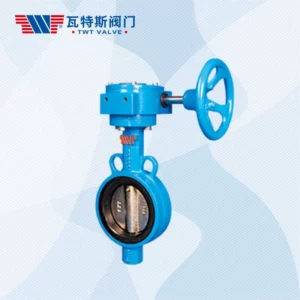A wafer butterfly valve is a type of valve used in piping systems to control the flow of fluids. The valve is called a wafer butterfly valve because it is designed to fit between two flanges in a wafer-like configuration, with no bolts or nuts required for installation.
Here are some features and benefits of a wafer butterfly valve:
Design: A wafer butterfly valve features a disc-shaped closure element that rotates around a central axis to control the flow of fluid through the valve. The valve is designed to fit between two flanges in a wafer-like configuration, making it easy to install and remove.
Size: Wafer butterfly valves are available in a range of sizes, from small sizes suitable for residential or commercial plumbing applications to large sizes used in industrial piping systems.
Pressure rating: The pressure rating of a wafer butterfly valve depends on the specific valve and manufacturer, but they are commonly rated for a maximum pressure of 10 bar (or approximately 145 psi).
Flow control: A butterfly valve provides excellent flow control capabilities, with the ability to quickly and easily adjust the flow of fluid through the valve using the disc element.
Durability: Wafer butterfly valves are typically made from durable materials such as cast iron, stainless steel, or PVC. This makes them resistant to wear and corrosion, ensuring a long service life.
Cost-effective: Wafer butterfly valves are typically less expensive than other types of valves, making them a cost-effective option for many applications.
Overall, a wafer butterfly valve can provide reliable and efficient flow control in a wide range of applications. When selecting a wafer butterfly valve, it’s important to consider the specific requirements of your application, including the size, pressure rating, and material of the valve, as well as any additional features such as actuation or position sensing capabilities.
Selecting the right wafer butterfly valve for your application requires careful consideration of several factors.
Here are some of the key factors to consider:
Size: The size of the valve should be based on the diameter of the pipe it will be installed in. The valve size should match the pipe size to ensure proper flow control and prevent any restrictions or obstructions. It’s important to measure the pipe diameter accurately to select the correct valve size.
Material: The material of the valve should be selected based on the type of fluid being transported through the pipe. For example, if the fluid is corrosive or abrasive, a valve made from corrosion-resistant materials such as stainless steel or PVC may be necessary. Similarly, if the fluid is at an extreme temperature, a valve made from materials that can withstand high temperatures may be required.
Pressure rating: The pressure rating of the valve should be based on the maximum pressure of the fluid being transported through the pipe. If the pressure exceeds the valve’s rating, it may result in valve failure or damage.
Actuation: Consider whether the valve requires manual or automated actuation. Manual actuation may be sufficient for smaller valves, wafer butterfly valve while larger valves may require automated actuation such as motors or pneumatic actuators.
Temperature range: Consider the temperature range of the fluid being transported through the pipe. If the fluid is at an extreme temperature, a valve made from materials that can withstand high temperatures may be required.
Compatibility: The wafer butterfly valve should be compatible with the flanges used in your piping system. Check the valve and flange dimensions to ensure they match.
Application: Consider the specific application of the valve, including the type of fluid being transported, the flow rate, and the required flow control. Some valves may be better suited for certain applications than others.
When selecting a wafer butterfly valve, it’s important to consult with a qualified valve supplier or engineer who can assist with selecting the appropriate valve based on the specific requirements of your application. They can help ensure that the valve is sized correctly, made from the appropriate materials, and has the necessary features to ensure reliable and efficient flow control.
